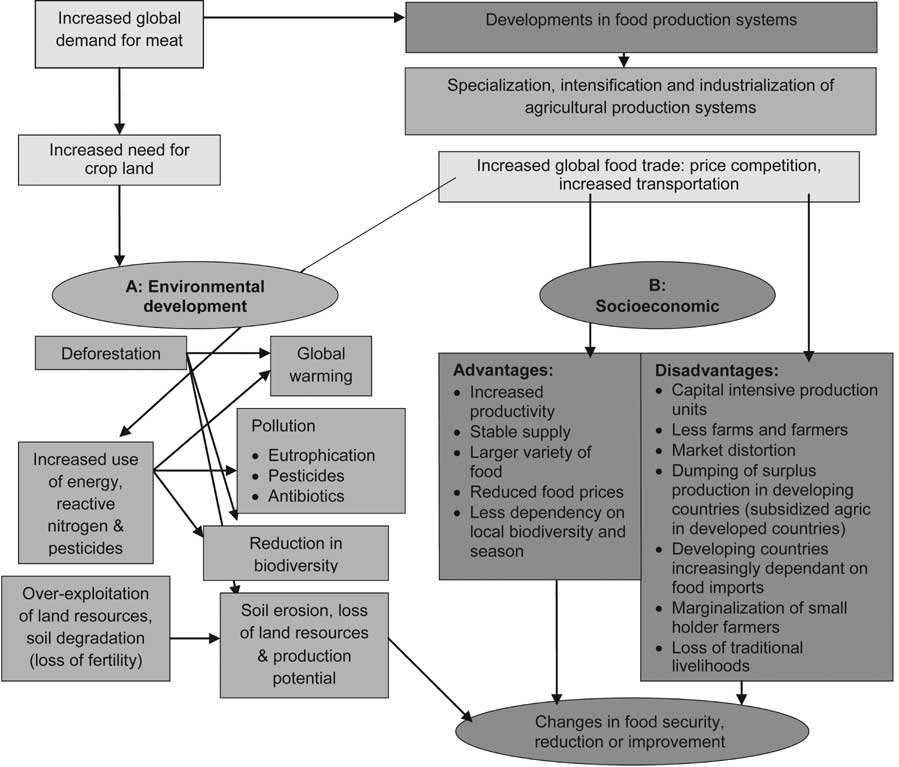
| Previous | Return to table of contents | Search Reports | Next |
| « Back to weltagrarbericht.de | ||
Historical Analysis of the Effectiveness of AKST Systems in Promoting Innovation | 109

Figure 2-6. Potentially problematic social and environmental aspects of global food systems sustainability. Source: adapted from Knudsen et al., 2005.
|
Bangladesh, benefited the poor and the landless as well as those with resources and that small-scale farmers adopted faster than large scale farmers (Crosson and Anderson, 2002), but in many countries evidence demonstrates that better resourced individuals and firms benefited, sometimes at the expense of the poor and landless (see 2.2). Food trade. The Uruguay Round of Trade Negotiations saw agriculture and food issues placed firmly within the WTO although some countries and organizations argued against their inclusion, maintaining that countries should have the right to determine their own policies on such an important issue as food security, i.e., they adopted a "food sovereignty" position (FOEI, 2001). Nonetheless, the 1994 WTO Agricultural Agreement adopted minimum import requirements and tariffs and producer subsidies that were accessible to transnational corporations both in USA and Europe (McMichael, 2001; Lyson, 2005), allowing them to operate economies of scale that lowered agricultural product prices all over the world (Welch and Graham, 1999; Wilson, 2005). Consumers and national economies benefited substantially from this agreement. These trends also opened up agricultural and food markets for the northern hemisphere commodities, with USA becoming the major exporter of cereals (with surplus being disposed of as food aid; Johnson, 2000) and Australia and New Zealand of dairy products. This development negatively affected local producers in developing countries; many countries, particularly in sub-Saharan Africa, increasingly became food importers (FAO, 2004). In developed countries, control of the food |
system became vertically integrated from seeds; production inputs; processing; transportation and marketing, forming food chain clusters (LaBelle, 2005; Lyson, 2005) and consequently, many small-scale producers lost their livelihoods (Watkins, 1996; Welch and Graham, 1999; Robinson and Sutherland, 2002; Wilson, 2005), migrating to towns where they faced new livelihood challenges and opportunities. Food security (Box 2-10 and Figures 2-7 and 2-8) greatly improved over the last few decades as a result pf the increase in global food production (Johnson, 2000; Crosson and Anderson, 2002) and the global grain trade (Johnson, 2000). Although increases in global food production (Paarlberg, 2002; Knudsen et al., 2005) surpassed population growth (Crosson and Anderson, 2002; Bruinsma, 2003; Knudsen et al., 2005), and was accompanied by an increase in the poorer country's average food consumption, (Garrett, 1997; Stringer, 2000; Johnson, 2000), food and nutritional insecurity persisted throughout the world even in countries which achieved national food security (Mellor, 1990; Stringer, 2000; LaBelle, 2005), particularly in sub- Saharan Africa (Wafula and Ndiritu, 1996; Knudsen et al., 2005). Protein energy malnutrition in developing countries declined from as high as 46.5% in the early 1960s to as low as 17% in the late 1990s (Khush, 2001; Young, 2004), with Africa contributing about a quarter (24%) of the total undernourished population globally (Young, 2004). This phenomenon corresponds with the proportion of those with prolonged deficits in required energy intake as chronic food shortages fell in Asia and Latin America except sub-Saharan |
| Previous | Return to table of contents | Search Reports | Next |
| « Back to weltagrarbericht.de | ||